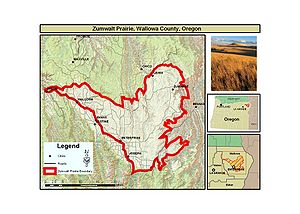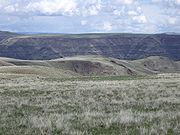
Zumwalt Prairie
Encyclopedia


Grassland
Grasslands are areas where the vegetation is dominated by grasses and other herbaceous plants . However, sedge and rush families can also be found. Grasslands occur naturally on all continents except Antarctica...
area located in Wallowa County
Wallowa County, Oregon
Wallowa County is a county located in the U.S. state of Oregon. It is included in the 8 county definition of Eastern Oregon. According to Oregon Geographic Names, the origins of the county's name are uncertain, with the most likely explanation being that it is derived from the Nez Perce term for a...
in northeast Oregon
Oregon
Oregon is a state in the Pacific Northwest region of the United States. It is located on the Pacific coast, with Washington to the north, California to the south, Nevada on the southeast and Idaho to the east. The Columbia and Snake rivers delineate much of Oregon's northern and eastern...
, United States
United States
The United States of America is a federal constitutional republic comprising fifty states and a federal district...
. Measuring 330000 acres (133,546.4 ha), much of the land is used for agriculture, with some portions protected as the Zumwalt Prairie Preserve owned by The Nature Conservancy
The Nature Conservancy
The Nature Conservancy is a US charitable environmental organization that works to preserve the plants, animals, and natural communities that represent the diversity of life on Earth by protecting the lands and waters they need to survive....
. The high altitude prairie is along the west edge of Hells Canyon
Hells Canyon
Hells Canyon is a wide canyon located along the border of eastern Oregon and western Idaho in the United States. It is North America's deepest river gorge at and part of the Hells Canyon National Recreation Area....
on the Oregon-Idaho
Idaho
Idaho is a state in the Rocky Mountain area of the United States. The state's largest city and capital is Boise. Residents are called "Idahoans". Idaho was admitted to the Union on July 3, 1890, as the 43rd state....
border.
Geography
The Zumwalt Prairie grassland is situated on a basaltBasalt
Basalt is a common extrusive volcanic rock. It is usually grey to black and fine-grained due to rapid cooling of lava at the surface of a planet. It may be porphyritic containing larger crystals in a fine matrix, or vesicular, or frothy scoria. Unweathered basalt is black or grey...
plateau
Plateau
In geology and earth science, a plateau , also called a high plain or tableland, is an area of highland, usually consisting of relatively flat terrain. A highly eroded plateau is called a dissected plateau...
which varies in elevation from 3500 to 5500 ft (1,066.8 to 1,676.4 m) and is dominated by several native bunchgrasses, including Idaho Fescue
Fescue
Festuce is a genus of about 300 species of perennial tufted grasses, belonging to the grass family Poaceae . The genus has a cosmopolitan distribution, although the majority of the species are found in cool temperate areas...
(Festuca idahoensis
Festuca idahoensis
Festuca idahoensis is a species of grass known by the common names Idaho fescue and blue bunchgrass. It is native to western North America, where it is widespread and common...
), Bluebunch wheatgrass
Bluebunch wheatgrass
Pseudoroegneria spicata is a species of grass known by the common name Bluebunch Wheatgrass. This native western North American perennial bunchgrass is known by the scientific synonyms Elymus spicatus and Agropyron spicatum. The grass can be found from Alaska to Texas. It occurs in many types of...
(Pseudoregnaria spicata), Sandberg's Bluegrass
Poa
Poa is a genus of about 500 species of grasses, native to the temperate regions of both hemispheres. Common names include meadow-grass , bluegrass , tussock , and speargrass. "Poa" is Greek for fodder...
(Poa secunda
Poa secunda
Poa secunda is a widespread species of grass native to North America. It is highly resistant to drought conditions, and provides excellent fodder.-External links:**...
) and many species of wildflowers. The Zumwalt Prairie is a piece of a once extensive temperate grassland system west of the Rocky Mountains which extended into Canada. The Zumwalt Prairie grassland system remains largely intact unlike most other prairies in North America. This fact can be attributed to its high elevation, harsh climate, and poor soils which made agriculture difficult. Because most of the Zumwalt Prairie escaped the plow, much of the important habitat remains for the plants and animals.
Wildlife
Zumwalt Prairie is home to a diverse array of raptor species and includes the grassland-dependent ferruginous hawkFerruginous Hawk
The Ferruginous Hawk , Buteo regalis , is a large bird of prey. It is not a true hawk like sparrowhawks or goshawks, but rather belongs to the broad-winged buteo hawks, known as "buzzards" in Europe...
(Buteo regalis), swainson's hawk
Swainson's Hawk
The Swainson's Hawk , is a large buteo hawk of the Falconiformes, sometimes separated in the Accipitriformes like its relatives. This species was named after William Swainson, a British naturalist...
(Buteo swainsoni), rough-legged hawk (Buteo lagopus), and the red-tailed hawk
Red-tailed Hawk
The Red-tailed Hawk is a bird of prey, one of three species colloquially known in the United States as the "chickenhawk," though it rarely preys on standard sized chickens. It breeds throughout most of North America, from western Alaska and northern Canada to as far south as Panama and the West...
(Buteo jamaicensis). Golden eagles (Aquila chrysaetos) are a common site soaring high above the prairie. The Zumwalt also supports important breeding populations of grassland songbirds, including Savannah sparrow (Passerculus sandwichensis), western meadowlark (Sturnella neglecta), vesper sparrow (Pooecetes gramineus), horned lark (Eremophila alpestris) and grasshopper sparrow (Ammodramus savannarum). Grassland birds are highly threatened and many need large areas to maintain viable populations. The Columbian Sharp-tailed Grouse
Columbian Sharp-tailed Grouse
The Columbian Sharp-tailed Grouse is a subspecies of Sharp-tailed Grouse native to the Western United States and British Columbia.-Description:...
, which had been extirpated from the Prairie by 1947 is being reintroduced in an effort spearheaded by Oregon Department of fish and wildlife.
Other wildlife includes Belding's ground squirrels (Spermophilus beldingi), northern pocket gophers (Thomomys talpoides), Rocky mountain elk (Cervus elaphus), black-tailed deer (Odocoileus hemionus), black bear (Ursus americanus), cougar (Felis concolor), bobcat (Lynx rufus), badgers and coyotes (Canis latrans) . After an approximately 50 year absence, gray wolves (Canis lupus) have begun to colonize northeastern Oregon and have been seen on the Zumwalt Prairie.
Climate
The climate of the Zumwalt Prairie is continental and semi-aridSemi-arid
A semi-arid climate or steppe climate describes climatic regions that receive precipitation below potential evapotranspiration, but not extremely...
. On average the Zumwalt Prairie receives 15 to 17 in (38.1 to 43.2 cm) of precipitation
Precipitation (meteorology)
In meteorology, precipitation In meteorology, precipitation In meteorology, precipitation (also known as one of the classes of hydrometeors, which are atmospheric water phenomena is any product of the condensation of atmospheric water vapor that falls under gravity. The main forms of precipitation...
yearly with the majority of the precipitation during winter months. The summer months of July and August are dry with a mean monthly rainfall of 1.25 inches (31.8 mm) and a mean daily maximum temperature of 84 °F (28.9 °C). Winters are cold with a mean daily minimum temperature of 16 °F (-8.9 °C).
History
The Chief JosephChief Joseph
Hin-mah-too-yah-lat-kekt, popularly known as Chief Joseph, or Young Joseph was the leader of the Wal-lam-wat-kain band of Nez Perce during General Oliver O. Howard's attempt to forcibly remove his band and the other "non-treaty" Nez Perce to a reservation in Idaho...
band of the Nez Perce were the original human inhabitants of the Zumwalt Prairie who used the area for hunting and gathering in the spring and fall. Euro-American settlement of the area began in the 1850s. The Nez Perce were forced out of the area in the late 1870s after President Ulysses S. Grant
Ulysses S. Grant
Ulysses S. Grant was the 18th President of the United States as well as military commander during the Civil War and post-war Reconstruction periods. Under Grant's command, the Union Army defeated the Confederate military and ended the Confederate States of America...
officially opened Wallowa County to white settlement. As of 2008, the prairie consists mostly of privately owned ranches and is used for summer grazing of cattle
Cattle
Cattle are the most common type of large domesticated ungulates. They are a prominent modern member of the subfamily Bovinae, are the most widespread species of the genus Bos, and are most commonly classified collectively as Bos primigenius...
.
Conservation
The Nature ConservancyThe Nature Conservancy
The Nature Conservancy is a US charitable environmental organization that works to preserve the plants, animals, and natural communities that represent the diversity of life on Earth by protecting the lands and waters they need to survive....
, a non-profit environmental conservation organization, owns and operates a nature preserve on the Zumwalt Prairie, and has undertaken several initiatives to understand and protect the biodiversity of the Zumwalt Prairie's ecosystems. These include biological inventories, ecological monitoring, and scientific research.

